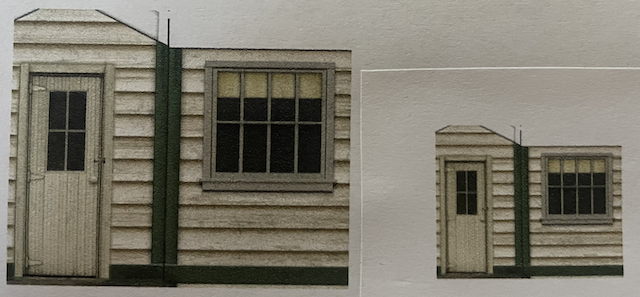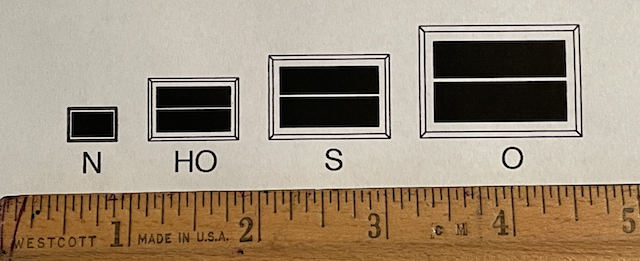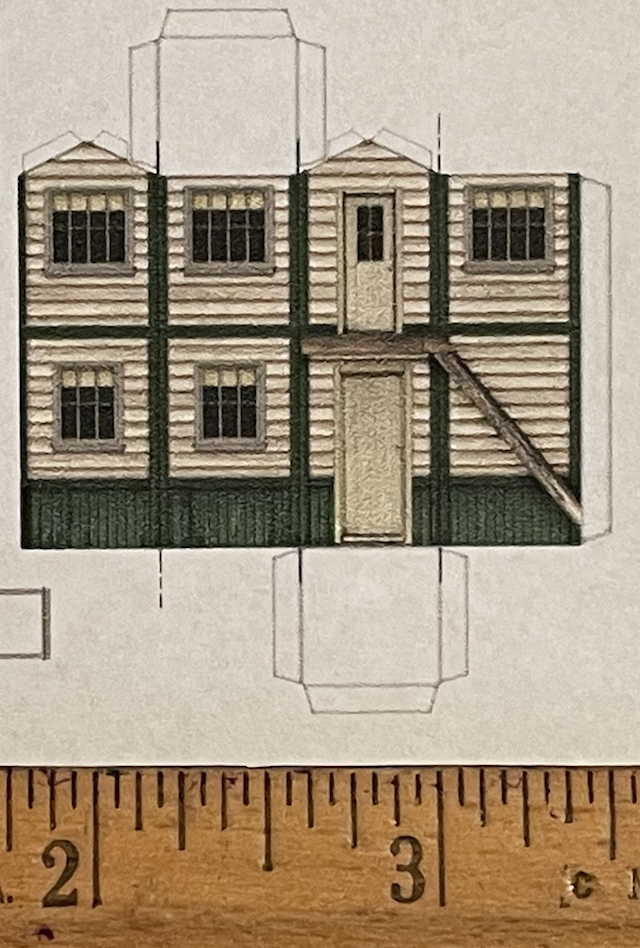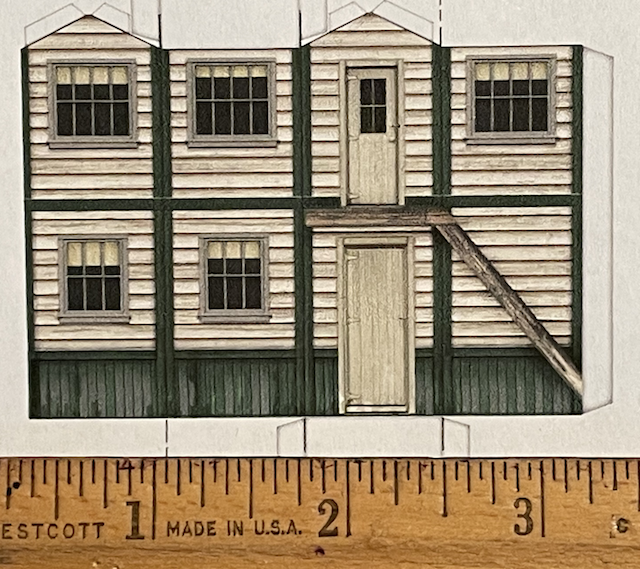The "IMPORTANT OPEN THIS FOLDER FIRST" link was opened first and all 6 PDFs were downloaded to a folder I created called Clever Models. All 6 PDFs were read and reread. Next, the FREE HO scale crossing tower from the Clever Models' "Get Freebies" page was downloaded. Whether or not the crossing tower is available depends on what the Freebie is at the time the Website page was last updated. The HO scale, as well as the O scale, printed plan/texture sheets contain enough textures for two versions of the tower. One is greenish and the other whiteish. There are NO instructions for the crossing tower, but... The previously downloaded PDF titled "6 Ben Streeter Typical Kit Assembly Tutorial 05 15 14.pdf" covers the construction of the crossing tower in O scale. When rereading the "2 Please Read this Second.pdf", I also noted that there are two PDFs regarding windows. They were also read and studied as they demonstrated how to make more realistic windows and doors. I thought I'd like to try their window and door methods on this model. I printed out the "squaregatehouse_HO.pdf" for the crossing tower. The structure and individual parts were small in HO scale, extremely small! The printed HO scale structure floor plan is almost a square measuring approximately 18mm on each side. 18mm = 0.708661" or just a bit over 11/16" on each side. In full scale that would be 61.65" or about 5' 1-5/8" on each side. The HO height is about 52.5mm. 52.5mm = 2.066929". In full scale that would be about 179.8" or about 15 feet. Looking at the HO printed sheet, it was apparent that it would be a real challenge to cut out some of the parts, if I could do it at all. I also noted that the 2nd floor door height was just a bit shy of 19mm on the printed HO scale parts plan. 19mm, in HO scale is 65". That makes the door height approximately 5' 5". That seems quite short to me. To verify the 2nd floor door height, the O scale version was downloaded and the second floor door area was printed. (It was also FREE at this time.) The O scale 2nd floor door measured about 34mm high. 34mm in O scale is 64.25". That makes the door height approximately 5' 4". It was difficult to measure these small sizes accurately, but they seemed close enough to demonstrate that the 2nd floor door was not close to correct height for "typical" folks to use easily. In the PDFs regarding 3D window construction, the topic of muntins came up. Muntins are a bar or rigid supporting strip between adjacent panes of glass. The window and door muntins, on the HO crossing tower, are very, very narrow. I tried to get an accurate measurement of their width, but it was impossible for me. Why did this matter? Cutting out window panes, as demonstrated in the window PDFs, without cutting through the muntins would be almost impossible! When rereading the "1Please Read this First.pdf" I noted, "All future releases, and previous ones as they get updated, will be sized to print in O scale, (1:48) ...". The O scale version of the crossing tower was also available, and it was downloaded. Using Adobe Acrobat Reader's "Take a Snapshot" function, a selection of part of the O scale PDF was made and then printed. The same snapshot was printed at 55%, to create the HO size. The HO size was compared to the full printed HO page and found to be exactly the same.  The O scale version is on the left and HO version on the right. The photo also demonstrates why some techniques, noted by Clever Models, may only work in O scale and not HO scale. Note the width difference in the window muntins! I measured the O scale muntins. The O scale window vertical muntins were about 1mm wide and the horizontals about 0.5mm wide. Both of the door's window muntins appeared to be about 0.33mm wide. Next I calculated the full size equivalent widths to compare them to real world measurements. The following are the real world calculated widths:
The real world measurements seemed about correct to me, but I don't have access to those types of doors and windows. This was more of curiosity question answered. More importantly, were they actual muntins' width of the HO model. These numbers were mathematically calculated using the measured O scale widths.
Those muntins' widths explain why it is totally impractical to try and cut out the window panes, as described by Clever Models. It also explains why I thought that HO and N scale windows and doors never looked quite right in "plastic type" kits. I've recently noted that windows do look black when not lit from the inside, but windows without screens appear shiny while those with screens on them appear flat, or matte. All of this information led to further investigations. My house has double-hung windows. I measured one of them and drew it in my CAD program. The full scale window was used to make O scale, S scale, HO scale and N scale sizes of that window.  The horizontal frame line, 1-3/4" in the real world, between the upper and lower windows has "disappeared" in the N scale version of this double-hung window. I printed a N scale version of the control tower to compare it to the HO version. 
It is easy to see, using the 1/16" ruler marks, how much narrower the vertical muntins are on the N scale version of the windows. The door muntins on the N scale version are almost not there. Returning to my statement about the window and door sizes, used on plastic kits, not looking quite right to me, I found the following quite interesting. Woodland Scenics and Walthers Cornerstone use the same photos for their N scale and HO scale kits.
The standardization of doors, most likely, took place long after this structure would have been designed and built, but only being about 5' 5" tall was interesting, although I own a log cabin built in 1903 with an on site built main entry door that is maybe 5.5'. I printed the O scale upper floor and lower floor doors. I measured the print and did the calculations to full scale. The full scale 2nd floor door is 5' 5-3/16" high and 22-5/8" wide. The full scale 1st floor door is about 6' 2.5" high and 27-3/8" wide. The lower level door also seemed both short and narrow, even for the time period that it might have existed in. There were some small towers, but Clever Models' sizes just did not make sense to me. There are 6 photos of the MAL Crossing Jackson in the Michigan section. The tower is somewhat similar to what Clever Models wanted to create. This photo gives an idea of how big the 2nd floor door is. It has a person in the photo on the stairway landing, just outside the door. To me, the 2nd story door height in the photo seemed somewhat similar to today's doors, about 80-ish inches. I calculated that if the O scale version was printed using 68%, instead of the actual scaling of 55%, then the 2nd floor door would be about 80 scale inches (23.36mm) in HO scale. The PDF with the stairway and landing, squaregatehouse_pg03.pdf, appeared to have many of the smallest parts. It was printed at 68% to see if I could actually cut out the parts. The computer printed page was affixed to 110# cardstock with spray adhesive. I could not successfully cut out the 6 pane window sill and exterior frame. More importantly, I could not successfully cut out the stairway railing parts. Even though I'd completed three of these cardstock structures at this time, I did not have the skill, technique and patients to complete this model in HO scale. |
